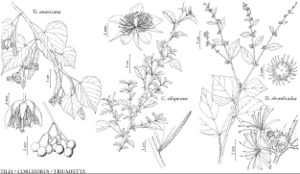Difference between revisions of "Triumfetta rhomboidea"
Enum. Syst. Pl., 22. 1760.
FNA>Volume Importer |
FNA>Volume Importer |
(No difference)
| |
Revision as of 22:44, 16 December 2019
Herbs, annual. Stems erect, branched, 3–18 dm, stellate-pubescent to glabrate. Leaves: petiole 1–5(–7) cm; proximal blades broadly ovate-orbiculate, rhombic, elliptic, or broadly ovate, usually palmately 3-lobed, 3–9(–15) cm, distal ovate to ovate-lanceolate or oblong-lanceolate, not lobed, base broadly cuneate or rounded to cordate or truncate, margins irregularly serrate, apex acute, surfaces: abaxial densely stellate-pubescent, adaxially sparsely stellate-pubescent, 3–5-veined from base. Inflorescences 3–5(–6) per axil, often subspicate; peduncle 1–3 mm. Pedicels 0.5–2 mm. Flowers: sepals narrowly oblong to linear-oblong, subapically appendaged, 4–5.5 mm, stellate abaxially; stamens 10–15; ovaries 3–4-locular. Capsules globose to ovoid-globose, 2.5–3 mm, surface densely tomentose-pilose; spines uncinate, glabrate, sparsely and minutely stipitate-glandular. 2n = 32.
Phenology: Flowering Oct–Dec.
Habitat: Roadsides, disturbed shrubby areas
Elevation: 10–50 m
Distribution

Ala., Fla., West Indies, introduced also in South America, Asia, Africa.
Discussion
The type of Triumfetta indica Lamarck is not conspecific with that of Bartramia indica and blocks transfer of B. indica to Triumfetta. Triumfetta bartramia Linnaeus, which pertains here, is an illegitimate, superfluous name, because Linnaeus cited the earlier B. indica.
Triumfetta rhomboidea is known from Florida only by collections from Broward, DeSoto, and Jackson counties, and from Alabama only by a collection from Houston County.
Selected References
None.
